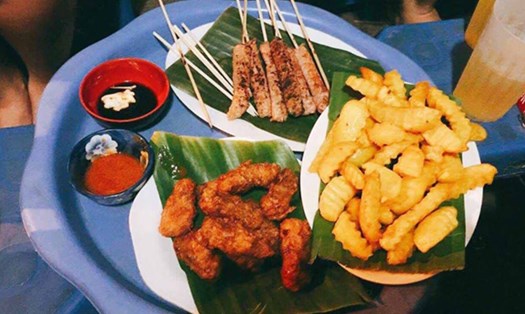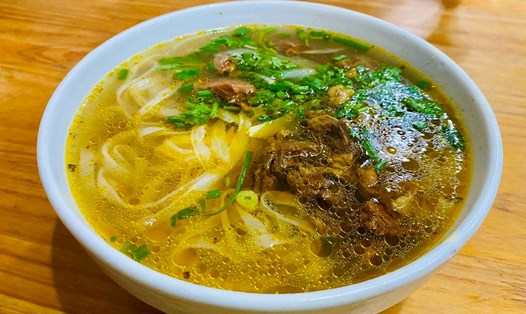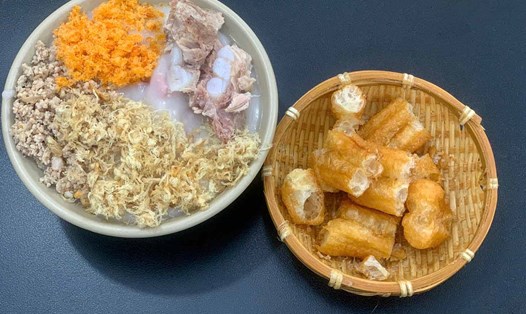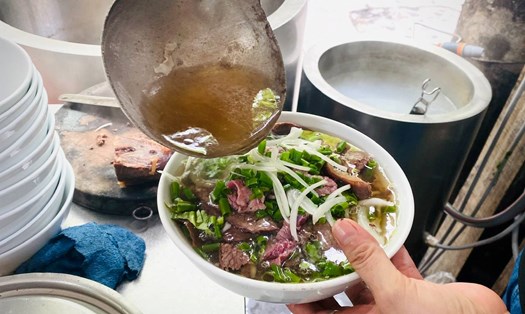This place has never grown or sold onions, yet it is called Hang Hanh. The place that sells the most onions in Hanoi is Cao Thang Street, near Dong Xuan Market, with an abundance of onions, garlic, ginger, turmeric, chili, lemongrass... So what is in Hang Hanh?
A UNIQUE ALLEY
The answer is, Hang Hanh Alley has strange characteristics that few alleys in the old quarter have. Firstly, there is Hang Hanh Alley without the support of Hang Hanh Street, like Cau Go Street has Cau Go Alley, Trang Tien Street has Trang Tien Alley, Dong Xuan Street has Dong Xuan Alley. This makes Hang Hanh Alley lonely.
Since its establishment, this place was called Hang Hanh, then the French named it Ruelle des Oignons, meaning Hang Hanh Alley. Geographically, Hang Hanh Alley is located back to back with Hang Gai Street, formerly selling hemp rope, later specializing in silk business.
Hang Hanh Alley continues Luong Van Can Street, making a crescent-shaped circle to Bao Khanh Alley. The length of Hang Hanh Alley is about 180 meters, with about fifty house numbers on both the even and odd sides. Although short, Hang Hanh Alley contains two craft villages: wood turning and leather shoemaking, closely related to the craftsmen's guilds on To Tich Street and Hang Giay Street.
Not only that, Hang Hanh alley also has 2 temples to worship the ancestors of the profession. Nhi Khe Vong Tu at house number 11 Hanh Hanh worships the founder of the wood turning profession named Doan Tai, and Pha Truc Lam at house number 40 worships the founder of the leather shoe making profession. Nhi Khe Vong Tu temple was built first, and is more majestic than Pha Truc Lam temple, however, after the change of the times, it was encroached upon, so now it is more modest.
Having two temples worshipping the ancestors of the craft in the same alley is certainly the strangest thing about Hang Hanh. And it adds to the mystery of the alley's name, because both guilds of craftsmen have nothing to do with onions or garlic. Many sources try to explain that this was once a place to grow onions or wash onions before selling, but all have no basis.
We only know that, since the 18th century, Hang Hanh alley was the place where Nhi Khe villagers (Thuong Tin) lived and worked, making wood. At the end of the alley was a leather shoemaking guild where people from the upper and lower Cham villages (Hai Duong) came to make a living.
The people of Hang Hanh alley are almost all wood lathe workers, using foot-pedal lathes to create items such as trays, candlesticks, incense burners, stair lathes, wooden trays, wooden bowls, chess pieces, and spinning tops. The finished lathes are always sold in their raw form to traders, while the lacquering and gilding are done by other craftsmen.
The lathe skills of the people of Hang Hanh alley were so famous that they were invited to participate in the construction of the Ba Dinh stage in the historic September days of 1945. The lathe worker who used to live at house number 5 Hang Hanh was the one who commanded the group of workers to do that project, so that the Declaration of Independence could be heard loudly.
The wooden products of Hang Hanh alley residents are famous and consumed very well not only in Hanoi but also throughout the country. In its heyday, 80% of Hang Hanh alley residents worked in the lathe profession. Later, they also expanded to other professions such as carving seals, stamps, wooden seals and even woodblock carving on Hang Gai and To Tich streets, which are still in operation today.
THE WAVES COME PASSING BY
After 1954, the wood turning and leather shoe making professions gradually faded away and eventually disappeared. New generations replaced the old ones, causing people to gradually forget the sophisticated turnings or sturdy leather shoes of the people of Hang Hanh alley.
Especially in the past 25 years, Hang Hanh Alley has completely transformed, with no trace of the workers' quarters and laborers left. The houses in the alley have been turned into restaurants, hotels, coffee shops, bars, beer and wine shops, food stalls... to serve tourists and night-time partygoers.
In this alley, a series of famous coffee and tea shops have emerged. Previously, no one came to Hang Hanh to drink coffee, however, during that period of change, Nhan Coffee Shop has emerged as a place to enjoy sophisticated Hanoi coffee, no less than Giang Coffee Shop and Lam Coffee Shop, which are much older.
In addition to Nhan Coffee, Hang Hanh Alley is also famous for Dilmah and Lipton tea bag shops, creating a new wave of tea enjoyment in the early 2000s. Dozens of tea and coffee shops have created a trendy drinking space for young people in Hanoi, especially in the night time zone.
It can be said that Hang Hanh Alley is one of the fastest changing places to welcome the wave of opening and tourism. When the Internet appeared and became popular in Vietnam, this was also the place where the first Internet cafes (Cyber Cafe) opened, operating 24/7.
If you drink and play, you must eat. Food stalls have sprung up like mushrooms on Hang Hanh Street. In a winding alley with only about 50 house numbers, half of the alley has food stalls, with all kinds of Hanoi delicacies such as vermicelli, noodles, glass noodles, porridge, pho, sticky rice...
House number 29 in the alley is a familiar place for those addicted to bun thang and xoi ga. It is very difficult to gain recognition in the market for bun thang. Hanoi has hundreds of pho ga and bun mien ga restaurants, however, the number of restaurants selling edible bun thang can be counted on the fingers of one hand.
Bun thang is a sophisticated dish, requiring meticulousness, hard work, and skill from the housewife. From the steps of slicing the pork roll into thin layers, omelette the eggs into thin layers, then slicing the chicken breast into bite-sized pieces. Other indispensable spices are Vietnamese coriander, scallions, green onions, fresh lime and chili, shrimp paste, and crispy pickled radish.
Bun thang is easy to eat, has a delicate and elegant flavor, and is eye-catching and colorful: the green of Vietnamese coriander, spring onions, and cilantro; the white of vermicelli noodles and shredded chicken; the yellow of omelette and chicken skin; the deep brown of chicken thighs, radishes, and shrimp paste; the light pink of pork roll; and the red of chili and shrimp floss.
All are harmoniously blended in a rich, clear, sweet broth, imbued with the scent of dried shrimp, chicken, shiitake mushrooms... creating a delicious, elaborate, yet very sophisticated dish of Hanoi people. If we were to give an honest score, the bowl of bun thang in Hang Hanh alley would get 8 points for presentation and 7.5 points for flavor.
That score is enough for those who have never eaten Bun Thang to feel secure to enjoy this dish in Hang Hanh Alley. That is why the restaurant's regular customers are mostly tourists from far away or overseas Vietnamese. Every time they come to Hanoi, they have to come here to eat a bowl of Bun Thang.
However, the chicken sticky rice of this restaurant deserves a higher score. A chef in Ho Chi Minh City had to give a lot of praise to the chicken sticky rice here. At that time, the restaurant was about to close, the sticky rice was almost done, but the sticky rice grains were still plump and soft, absorbing the fat of the chicken, making the sticky rice strangely delicious. No matter what, Hanoians still cook sticky rice at the best of the best.
It is the bowls of bun thang, sticky rice with chicken, cups of tea, and cups of coffee that have created a new look for Hang Hanh Alley. There is no longer the sound of the wooden lathe or the loud sound of shoe making; nor is there the desolate alley with only cyclos and handcarts coming and going; Hang Hanh Alley is now a service that operates all day and all night.
That transformation has caused the price of houses in Hang Hanh Alley to increase to an unbelievable level, forcing even the most loyal residents of the alley to sign the papers to sell their houses. It may be a pity, but Hang Hanh Alley cannot avoid that fate. Just like before, the alley has transformed from a wasteland into a residential area for lathe workers.




